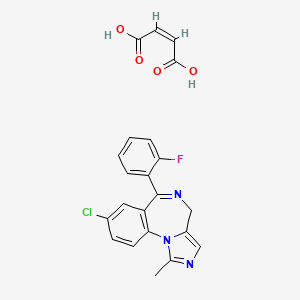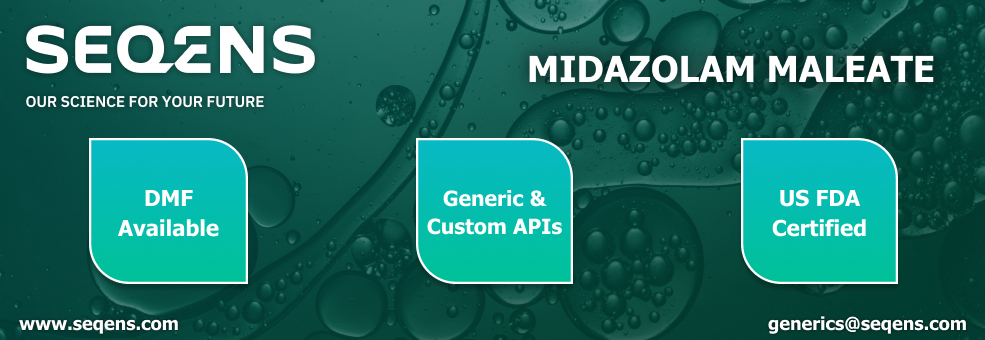



1. Dormicum
2. Hydrochloride, Midazolam
3. Maleate, Midazolam
4. Midazolam
5. Midazolam Hydrochloride
6. Ro 21 3981
7. Ro 21-3981
8. Ro 213981
9. Versed
1. 59467-94-6
2. Midazolam Maleate Salt
3. Midazolam Maleate [usan]
4. Ro 21-3981/001
5. Midazolam (as Maleate)
6. Nsc-313452
7. Buccolam
8. Hypnovel
9. Versed
10. 8-chloro-6-(o-fluorophenyl)-1-methyl-4h-imidazo(1,5-a)(1,4)benzodiazepine Maleate (1:1)
11. 77520s18se
12. Ro-213981-003
13. Dormicum Maleate
14. Midazolam Maleate (usan)
15. Ro-21-3981/001
16. (z)-but-2-enedioic Acid;8-chloro-6-(2-fluorophenyl)-1-methyl-4h-imidazo[1,5-a][1,4]benzodiazepine
17. 4h-imidazo(1,5-a)(1,4)benzodiazepine, 8-chloro-6-(2-fluorophenyl)-1-methyl-, (z)-2-butenedioate (1:1)
18. Einecs 261-775-0
19. Ro-21-3981/003
20. Unii-77520s18se
21. Schembl147776
22. Midazolam Maleate [mi]
23. Chembl2106922
24. Iti-111
25. Nvd-301
26. Midazolam Maleate [mart.]
27. Midazolam Maleate [who-dd]
28. Nsc313452
29. Nsc 313452
30. 8-chloro-6-(2-fluorophenyl)-1-methyl-4h-imidazo(1,5-a)(1,4)benzodiazepine Monomaleate
31. D05028
32. 467m946
33. Q27266551
34. 8-chloro-6-(2-fluorophenyl)-1-methyl-4h-imidazo[1,5-a][1,4]benzodiazepine Maleate
35. 4h-imidazo[1,4]benzodiazepine, 8-chloro-6-(2-fluorophenyl)-1-methyl-, (z)-2-butenedioate (1:1)
| Molecular Weight | 441.8 g/mol |
|---|---|
| Molecular Formula | C22H17ClFN3O4 |
| Hydrogen Bond Donor Count | 2 |
| Hydrogen Bond Acceptor Count | 7 |
| Rotatable Bond Count | 3 |
| Exact Mass | 441.0891619 g/mol |
| Monoisotopic Mass | 441.0891619 g/mol |
| Topological Polar Surface Area | 105 Ų |
| Heavy Atom Count | 31 |
| Formal Charge | 0 |
| Complexity | 590 |
| Isotope Atom Count | 0 |
| Defined Atom Stereocenter Count | 0 |
| Undefined Atom Stereocenter Count | 0 |
| Defined Bond Stereocenter Count | 1 |
| Undefined Bond Stereocenter Count | 0 |
| Covalently Bonded Unit Count | 2 |
Treatment of prolonged, acute, convulsive seizures in infants, toddlers, children and adolescents (from three months to less than 18 years).
Buccolam must only be used by parents / carers where the patient has been diagnosed to have epilepsy.
For infants between three and six months of age, treatment should be in a hospital setting where monitoring is possible and resuscitation equipment is available.
Anti-Anxiety Agents
Agents that alleviate ANXIETY, tension, and ANXIETY DISORDERS, promote sedation, and have a calming effect without affecting clarity of consciousness or neurologic conditions. ADRENERGIC BETA-ANTAGONISTS are commonly used in the symptomatic treatment of anxiety but are not included here. (See all compounds classified as Anti-Anxiety Agents.)
Anesthetics, Intravenous
Ultrashort-acting anesthetics that are used for induction. Loss of consciousness is rapid and induction is pleasant, but there is no muscle relaxation and reflexes frequently are not reduced adequately. Repeated administration results in accumulation and prolongs the recovery time. Since these agents have little if any analgesic activity, they are seldom used alone except in brief minor procedures. (From AMA Drug Evaluations Annual, 1994, p174) (See all compounds classified as Anesthetics, Intravenous.)
GABA Modulators
Substances that do not act as agonists or antagonists but do affect the GAMMA-AMINOBUTYRIC ACID receptor-ionophore complex. GABA-A receptors (RECEPTORS, GABA-A) appear to have at least three allosteric sites at which modulators act: a site at which BENZODIAZEPINES act by increasing the opening frequency of GAMMA-AMINOBUTYRIC ACID-activated chloride channels; a site at which BARBITURATES act to prolong the duration of channel opening; and a site at which some steroids may act. GENERAL ANESTHETICS probably act at least partly by potentiating GABAergic responses, but they are not included here. (See all compounds classified as GABA Modulators.)
Hypnotics and Sedatives
Drugs used to induce drowsiness or sleep or to reduce psychological excitement or anxiety. (See all compounds classified as Hypnotics and Sedatives.)
Adjuvants, Anesthesia
Agents that are administered in association with anesthetics to increase effectiveness, improve delivery, or decrease required dosage. (See all compounds classified as Adjuvants, Anesthesia.)
N05CD08
